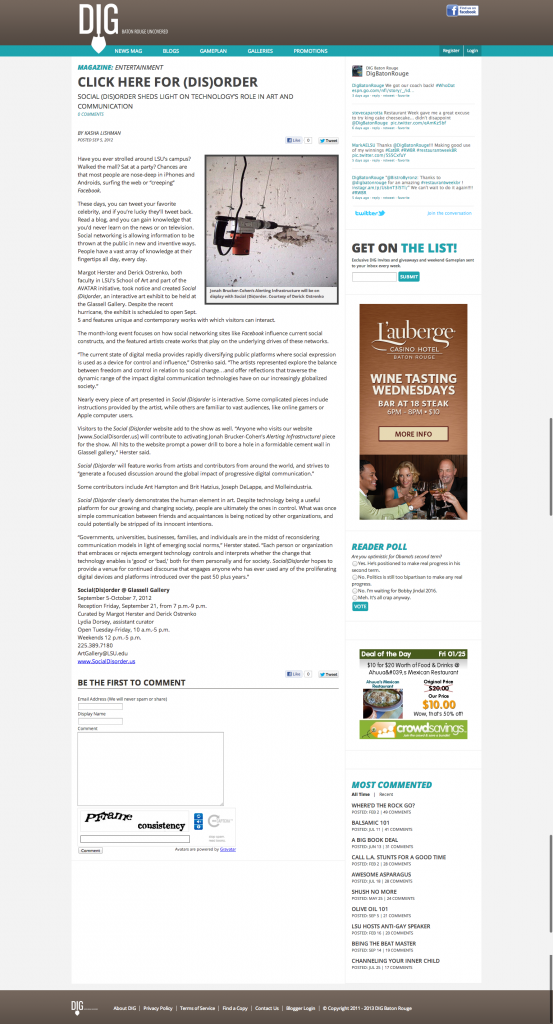Article written about social(dis)order in Dig Magazine. Click here for (dis)order.
http://digbatonrouge.com/article/click-here-for-dis-order-5727/
CLICK HERE FOR (DIS)ORDER
SOCIAL (DIS)ORDER SHEDS LIGHT ON TECHNOLOGY’S ROLE IN ART AND COMMUNICATION
BY KASHA LISHMAN
POSTED SEP 5, 2012
Have you ever strolled around LSU’s campus? Walked the mall? Sat at a party? Chances are that most people are nose-deep in iPhones and Androids, surfing the web or “creeping”Facebook.
These days, you can tweet your favorite celebrity, and if you’re lucky they’ll tweet back. Read a blog, and you can gain knowledge that you’d never learn on the news or on television. Social networking is allowing information to be thrown at the public in new and inventive ways. People have a vast array of knowledge at their fingertips all day, every day.
Margot Herster and Derick Ostrenko, both faculty in LSU’s School of Art and part of the AVATAR initiative, took notice and created Social (Dis)order, an interactive art exhibit to be held at the Glassell Gallery. Despite the recent hurricane, the exhibit is scheduled to open Sept. 5 and features unique and contemporary works with which visitors can interact.
The month-long event focuses on how social networking sites like Facebook influence current social constructs, and the featured artists create works that play on the underlying drives of these networks.
“The current state of digital media provides rapidly diversifying public platforms where social expression is used as a device for control and influence,” Ostrenko said. “The artists represented explore the balance between freedom and control in relation to social change…and offer reflections that traverse the dynamic range of the impact digital communication technologies have on our increasingly globalized society.”
Nearly every piece of art presented in Social (Dis)order is interactive. Some complicated pieces include instructions provided by the artist, while others are familiar to vast audiences, like online gamers or Apple computer users.
Visitors to the Social (Dis)order website add to the show as well. “Anyone who visits our website [www.SocialDisorder.us] will contribute to activating Jonah Brucker-Cohen’s Alerting Infrastructure! piece for the show. All hits to the website prompt a power drill to bore a hole in a formidable cement wall in Glassell gallery,” Herster said.
Social (Dis)order will feature works from artists and contributors from around the world, and strives to “generate a focused discussion around the global impact of progressive digital communication.”
Some contributors include Ant Hampton and Brit Hatzius, Joseph DeLappe, and Molleindustria.
Social (Dis)order clearly demonstrates the human element in art. Despite technology being a useful platform for our growing and changing society, people are ultimately the ones in control. What was once simple communication between friends and acquaintances is being noticed by other organizations, and could potentially be stripped of its innocent intentions.
“Governments, universities, businesses, families, and individuals are in the midst of reconsidering communication models in light of emerging social norms,” Herster stated. “Each person or organization that embraces or rejects emergent technology controls and interprets whether the change that technology enables is ‘good’ or ‘bad,’ both for them personally and for society. Social(Dis)order hopes to provide a venue for continued discourse that engages anyone who has ever used any of the proliferating digital devices and platforms introduced over the past 50 plus years.”
Social(Dis)order @ Glassell Gallery September 5-October 7, 2012 Reception Friday, September 21, from 7 p.m.-9 p.m. Curated by Margot Herster and Derick Ostrenko Lydia Dorsey, assistant curator Open Tuesday-Friday, 10 a.m.-5 p.m. Weekends 12 p.m.-5 p.m. 225.389.7180 ArtGallery@LSU.edu www.SocialDisorder.us
</div>

